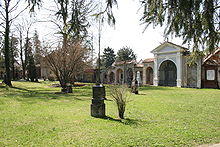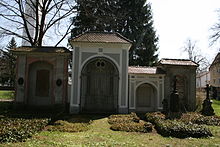Memmingen old cemetery
The old cemetery in the Swabian town of Memmingen is an abandoned cemetery . The site covers around 16,000 square meters.
The area of the cemetery served the Schottenkloster Memmingen from 1167 . This was incorporated into the Augustinian monastery in Memmingen in 1498 and the monastery buildings demolished in 1512 and the church in 1529.
As early as 1521, considerations have been handed down that the imperial city cemeteries in front of St. Martin and Unser Frauen should be relocated because they were no longer sufficient. After the illness of English sweat broke out in 1529 , the shortage of space worsened again. So the city council decided to set up the new city cemetery on the open area of the former Schottenkloster. The cemetery was divided into different areas. Up until the beginning of the 19th century, it was subdivided by two crossing main paths and divided into four quarters. The cemetery wall was completed in 1509. The graves of the noble and wealthy families with large and noble graves were located in the southwest and northwest. These two quarters of the cemetery used to be built on with the monastery buildings and the Schottenklosterkirche. They were the furthest away from the Knollenmühlbach , so the risk of flooding was classified as low. In the south-western quarter, a space was reserved for a community grave for poor tanners. The tanners' guild had to pay for the funerals. The south-eastern quarter was reserved for burials of poor people in need and those who had died from children's, hospital, breeding, soul and infirmary houses. In the farthest corner of the neighborhood, the death row convicts were also buried. The north-western quarter was intended for citizens who did not have a family grave and for immigrants from the Defereggental in Tyrol . In the last quarter, people without civil rights, foreigners, Catholics, Reformed and the Hitzenhofen farmers were buried.
When the lack of space made an expansion essential in 1866, various measures were taken to create more space in the churchyard. This included, among other things, the abandonment of the gravedigger's vegetable garden and the shortening of the idle time. The city was able to acquire a plot of land in the south up to Augsburger Straße and in 1873 the cemetery area was completely redesigned. Only the large family graves were preserved. The entire cemetery was covered with a grid, a denominational division of the cemetery was excluded due to the free allocation. On August 1, 1874, construction began on the morgue with a 9.2-meter-long, 9-meter-wide and 5.5-meter-high hall, six corpse cells, a dissecting room, a doctor's room and the keeper's bedroom on the northwest corner of the cemetery . The keeper's apartment was in a two-story extension.
Towards the end of the 19th century, despite the expansion, there was not enough space for the growing city population. After various considerations, the idea of a new cemetery prevailed. The Memmingen forest cemetery was opened in 1920 . Only individual burials were still permitted in the old cemetery, mostly if it was the last member of a family that already had a family grave in the old cemetery. In 1929 the desire was expressed to beautify the graves that still existed in the old cemetery, which the city council did not approve because of further use by individual burials. In the first inventory lists from 1958 for extraordinary and valuable monuments, individual grave monuments were already listed. Nevertheless, the cemetery should be leveled in 1962. After the city council passed the resolution on November 29, 1962, the redesign began. Walter Braun , home curator and city councilor presented a list of 60 grave monuments that should definitely be preserved. In 1965 the city council made 5000 DM available for the renovation work. The cemetery wall facing Augsburger Strasse was removed from 1.2 to 1.5 meters. Based on a statute for the cemetery from 1904, it was determined in 1968 that the grave monuments worth preserving had to be preserved by the city and not cared for by the bereaved. In June 1971 it was decided to redesign the old cemetery as a park and to preserve the grave monuments, since apart from Memmingen there are only grave monuments from the 17th to 20th centuries in Lindau and Straubing. The cemetery was therefore included in the list of monuments as an ensemble.
Today the cemetery is abandoned and is used as a park. The Memmingen town band has its rehearsal room in the old morgue. Marching rehearsals for the chapel often take place in the former cemetery.
Web links
- The old cemetery on Memmingen.de
- The old cemetery on prodenkmal.de
- The old cemetery on denkmalprojekt.org
literature
- Christa Koepff, Werner Bachmayer, Claudia Berg: Memmingen's old cemetery - graves and résumés . In: Memminger Geschichtsblätter 2010/2011 . 2011, ISSN 0539-2896 .
- Tilmann Breuer : City and district of Memmingen (= Bavarian art monuments . Volume 4 ). Deutscher Kunstverlag, Munich 1959, p. 57 to 58 .
Individual evidence
- ↑ Bayernatlas measurement function. Retrieved January 7, 2017 .
- ↑ Christa Koepff, Werner Bachmayer, Claudia Berg: Memmingen's old cemetery - graves and résumés . In: Memminger Geschichtsblätter 2010/2011 . 2011, ISSN 0539-2896 , p. 11 .
- ↑ Christa Koepff, Werner Bachmayer, Claudia Berg: Memmingen's old cemetery - graves and résumés . In: Memminger Geschichtsblätter 2010/2011 . 2011, ISSN 0539-2896 , p. 15 .
- ↑ Christa Koepff, Werner Bachmayer, Claudia Berg: Memmingen's old cemetery - graves and résumés . In: Memminger Geschichtsblätter 2010/2011 . 2011, ISSN 0539-2896 , p. 15-16 .
- ↑ Christa Koepff, Werner Bachmayer, Claudia Berg: Memmingen's old cemetery - graves and résumés . In: Memminger Geschichtsblätter 2010/2011 . 2011, ISSN 0539-2896 , p. 20 .
Coordinates: 47 ° 59 ′ 17.7 ″ N , 10 ° 11 ′ 21.2 ″ E

